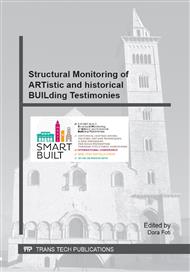[1]
S. Mastrodicasa, Dissesti statici delle Strutture Edilizie, seventh ed., Hoepli, Milan, (1983).
Google Scholar
[2]
M. Lepidi, V. Gattulli, D. Foti, Swinging-bell Resonances and their Cancellation Identified by Dynamical Testing in a Modern Bell Tower, Engineering Structures, 31 (2009), 1486-1500, ISSN: 0141-0296.
DOI: 10.1016/j.engstruct.2009.02.014
Google Scholar
[3]
D. Foti, S. Ivorra, M. F. Sabbà, Dynamic Investigation of an Ancient Bell Tower with Operational Modal Analysis, The Open Construction and Building Technology Journal, 6, (2012) 384-391, ISSN 1874-8368.
DOI: 10.2174/1874836801206010384
Google Scholar
[4]
D. Foti, Dynamic identification techniques to numerically detect the structural damage, The Open Construction and Building Technology Journal, 7 (2013) 43-50, ISSN 1874-8368.
DOI: 10.2174/1874836801307010043
Google Scholar
[5]
D. Foti, V. Gattulli, F. Potenza, Output-only identification and model updating by dynamic testing in unfavorable conditions of a seismically damaged building, Computer-Aided Civil and Infrastructure Engineering, 2 (2014), Online ISSN: 1467-8667.
DOI: 10.1111/mice.12071
Google Scholar
[6]
Council of Europe Recommendation of 1993, On the Protection of the Architectural Heritage against natural disasters, (1993).
Google Scholar
[7]
A. Menuge, Understanding Historic Buildings, ed. English Heritage, (2006).
Google Scholar
[8]
K. Tugce, G. Murat, B. Selcen, Artificial Neural Network to Predict Daylight Illuminance in Office Building, Building and Environment, 44(8) (2009) 1751-1757.
DOI: 10.1016/j.buildenv.2008.11.012
Google Scholar
[9]
N. Sriram, S. Suresh, N. Sundararajan, Direct Adaptive Neural Controller for Earthquake Excited Nonlinear Base Isolated Buildings, 22nd IEEE Int. Sym. on Intelligent Control, Singapore, (2007) 138-143.
DOI: 10.1109/isic.2007.4450874
Google Scholar
[10]
C. Jing, Z. Qingjie, S. Youpo, Predictive Model of Artificial Neural Network for Disaster Prevention. 2nd IEEE Int. Conf. on Information Management and Engineering (ICIME). Chengdu, China, (2010) 365-369.
Google Scholar
[11]
J. Wang, H. Gao, J. Xi, Application of Artificial Neural Network and GIS in Urban Earthquake Disaster Mitigation. Int. Conf. on Intelligent Computation Technology and Automation (ICICTA). Changsha, Hunan, China, 1 (2010) 726-729.
DOI: 10.1109/icicta.2010.409
Google Scholar
[12]
L. Carnimeo, A. Giaquinto, Cellular Neural Networks for Obstacle Detection in Stereo Vision Imagery, Cellular Neural Networks: Theory and Appl., I(8), New York, Nova Science Publishers, (2004), 173-180.
Google Scholar
[13]
XJ. Chen, ZF Gao, W. Wang, Application of BP Artificial Neural Network in Structure Damage Identification, Int. Conf. on Intelligent Computation Technology and Automation (ICICTA), Changsha, Hunan, China, 1 (2010) 733-737.
DOI: 10.1109/icicta.2010.150
Google Scholar


